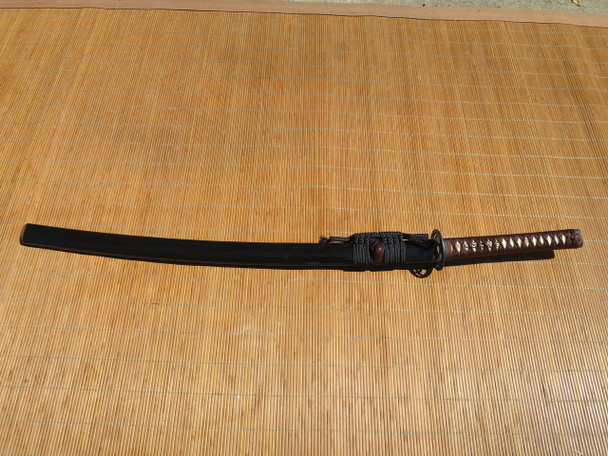Description
Ronin Elite Katana #239
This Ronin Elite katana has been traditionally forged and laminated in the soshu kitae tradition (seven panel steel). This school was developed by the legendary Japanese smith Masamune, and combines panels of hard, medium, and soft steels. The core of the blade is formed from softer, more malleable steel giving it exceptional flexibility. A layer of slightly harder steel is bonded to each side of the core to add support. The last layers are a very hard steel bonded to the top, bottom, and both sides of the core forming the ha (cutting edge) mune (back edge) and shinogi-ji (blade flats). This form of laminar construction provided for a sword that could be sharpened to a razor edge due to the hardened steed used for the ha, but was extremely resilient to battle damage due to its softer more flexible core.
Ronin elite katana are one of a kind, and the pictures are of the exact katana for sale.
Blade lamination: Soshu Kitae seven panel steel
Steel: 1095/1060/1045
Tempering: Differentially hardened (clayed) and water quenched
Rockwell Hardness: 62 edge / 40 spine
Fittings: Traditionally themed tsuba fuchi, kashira, and menuki
Kurikata, Koiguch, Kojirii: Polished buffalo horn
Polish: Japanese finger stone polish.
Blade length: 29 inches (habaki to tip)
Over all length: 40.9 inches
Tang: Full tang with Ronin kanji.
Grip: 10 inches
Wrap: Silk ito over genuine ray skin.
Saya: Silk sageo buffalo horn inserts
Ability level: Advanced dojo use (bamboo, tatami mats, etc)
1 Review
-
Very nice, but needs some TLC to make it great!
I purchased this sword about 2 weeks ago, and it is my first katana. I wanted a quality piece, and Ronin's Elite line was highly recommended as a high-quality weapon with some high-end finishes at a mid-range price. I was initially very impressed by the sword. The weight and balance seemed great, and the fittings were very tasteful and well done. Packaging: Cardboard box with Styrofoam inserts, some of which were broken. Everything was still in good shape though. Sword bag is nice and not too girly looking, but the tassels came off after only a couple of ties. Easy fix. Saya: Looks fantastic, with some minor microscratches in the lacquer. The only issue I had was that the kurigata had popped off. Upon inspection, I didn't see any glue residue at all on the bare wood or the fitting… someone was rushing. A few dabs of epoxy and 5 minutes later and it was on for good. You can tell if you look close, but it’s not noticeable for the most part. Tsuka: Ito is nice and tight, and is well wrapped. The top meguki-ana are off center and the peg has to go in at an angle. The holes in the same' are pretty rough and more oblong than circular. You can see a little bit of wood near the fuchi, so I wonder if the same is a channel wrap? Either way, it's on solidly and feels secure without and rattle, though I don’t know how it will hold up to cutting. Blade: Nice and sharp, with a pleasing hamon. The polish is well done, with some light scratches that will buff out easily. Didn’t see any telltale issues with the blade lamination or anything. However, not all was well... it took me a week to notice it, but the blade appeared to be bowed slightly to the right from the middle of the blade to the tip. Found some good light, and yep, it was bowed. Checked it with a square, still bowed. Went searching for the box intending to initiate an RMA, but I had already chukked it... so, I’m stuck with it. VERY disappointing. The bowing was gentle, so I figured I could correct it without compromising the metal. Fashioned a couple of wood jigs, applied some even momentary pressure, and after some checking and double-checking, the blade is now true. The bent blade is inexcusable to me, so I don’t think I’m going to be purchasing any more Ronin products. That said, having a few issues and learning how to competently correct them was a good experience for me. I would advise potential buyers to ask for an inspection of the blade prior to purchase. If they don’t respond, just move on. Also, ask for pictures of the other side of the tsuka.



















